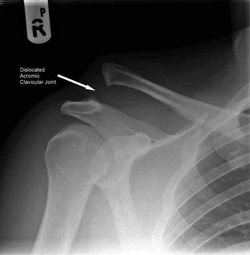Acromio-Clavicular Joint (ACJ) Reconstruction

Probably 80% of ACJ disruptions will do well treated conservatively with a supportive sling for the first few weeks followed by a gentle return to activity. The majority of people will be back to heavy lifting activities by 3 months.
Arthroscopic repair using the 'Tightrope'
In the more unstable injuries it may be preferable to repair early.
This can be done with an arthroscopic (keyhole) technique making three small cuts, as seen opposite.
Return to work can be quicker than with conservative treatment but heavy lifting should still be avoided for the first 3 months.
This technique can also be used to reduce and fix fractures of the end of the clavicle (collar bone)
Delayed repair of ACJ injuries
If the operation is not done within 4 weeks of injury then this technique alone may be insufficient. If an operation is still required then a 'Weaver Dunn' procedure which involves cutting off the end of the collar bone and inserting the end of a ligament called the coracoacromial ligament can be performed.
Alternatively the artificial 'Tightope' ligament may be used in combination with a hamstring tendon taken from the patients knee. This operation can sometimes be done through keyholes but may need a formal open approach
Arthroscopic repair using the 'Tightrope'
In the more unstable injuries it may be preferable to repair early.
This can be done with an arthroscopic (keyhole) technique making three small cuts, as seen opposite.
Return to work can be quicker than with conservative treatment but heavy lifting should still be avoided for the first 3 months.
This technique can also be used to reduce and fix fractures of the end of the clavicle (collar bone)
Delayed repair of ACJ injuries
If the operation is not done within 4 weeks of injury then this technique alone may be insufficient. If an operation is still required then a 'Weaver Dunn' procedure which involves cutting off the end of the collar bone and inserting the end of a ligament called the coracoacromial ligament can be performed.
Alternatively the artificial 'Tightope' ligament may be used in combination with a hamstring tendon taken from the patients knee. This operation can sometimes be done through keyholes but may need a formal open approach
Open Repair using a plate and screws

In patients with further bone growth expected it may be preferable to use a special hook plate and screws to fix the joint. This plate is inserted through a fairly large incision and usually will need to be taken out a few months later when the joint has healed
This technique can also be used to reduce and hold fractures of the end of the clavicle (collar bone)
This technique can also be used to reduce and hold fractures of the end of the clavicle (collar bone)
